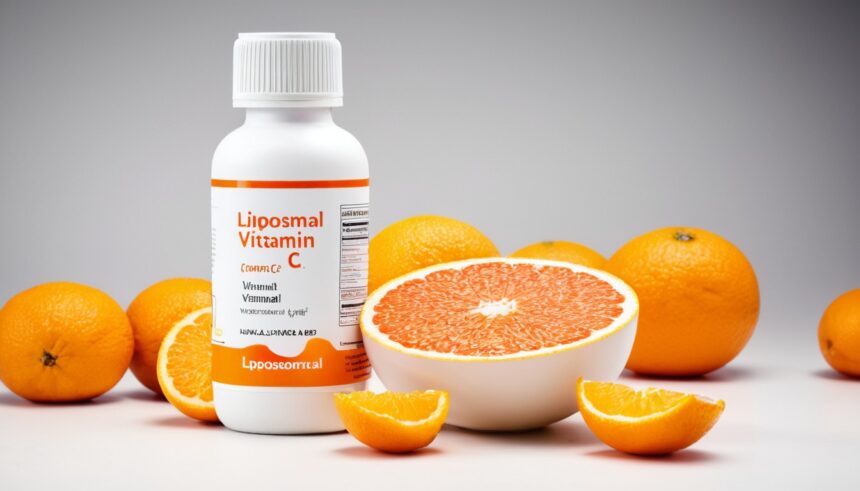Liposomal vitamin C is a form of vitamin C that is encapsulated in liposomes, which are tiny spheres made of phospholipids. This encapsulation process helps to protect the vitamin C from degradation and allows it to be more easily absorbed by the body.
Liposomal vitamin C has several benefits over other forms of vitamin C, including:
- Increased absorption: Liposomes can bypass the digestive system and deliver vitamin C directly to the bloodstream, resulting in increased absorption.
- Improved bioavailability: Liposomes protect vitamin C from degradation, which means that more of the vitamin is available to the body.
- Reduced side effects: Liposomal vitamin C is less likely to cause side effects, such as stomach upset and diarrhea, than other forms of vitamin C.
If you are looking for a way to improve your vitamin C intake, liposomal vitamin C is a great option. It is easy to make at home, and it offers several benefits over other forms of vitamin C.
Ingredients
To make liposomal vitamin C, you will need the following ingredients:
- 1 cup of distilled water
- 1/4 cup of sunflower lecithin
- 1/4 cup of vitamin C powder
- A blender or food processor
Instructions
- Combine the distilled water and sunflower lecithin in a blender or food processor. Process the mixture until it becomes creamy and smooth.
- Add the vitamin C powder to the mixture and blend until it is completely dissolved.
- Transfer the blend into a glass container or flask. Store the liposomal vitamin C in the refrigerator for up to 2 weeks.
Dosage
The recommended dosage of liposomal vitamin C is 1-2 tablespoons per day. You can take it with food or without any food.
Benefits of Liposomal Vitamin C
Liposomal vitamin C has several benefits, including:
- Boosts immunity: An immune system in good health requires vitamin C. It helps to protect the body from infection and disease.
- Reduces inflammation: Vitamin C is a powerful antioxidant that can help to reduce inflammation throughout the body.
- Improves skin health: The synthesis of collagen, a protein that gives skin its strength and suppleness, depends on vitamin C.
- Protects against heart disease: Vitamin C can help to lower cholesterol levels and reduce the risk of heart disease.
- Improves brain function: Vitamin C is essential for the production of neurotransmitters, which are chemicals that allow nerve cells to communicate with each other.
Side Effects of Liposomal Vitamin C
Liposomal vitamin C is generally safe for most people. Nevertheless, certain individuals might encounter adverse consequences like:
- Nausea
- Vomiting
- Diarrhea
- Stomach upset
- Headache
If you experience any side effects from liposomal vitamin C, stop taking it and talk to your doctor.
What are some other ways to increase my vitamin C intake besides liposomal vitamin C?
Here are some other ways to increase your vitamin C intake besides liposomal vitamin C:
- Eat citrus fruits: Citrus fruits, such as oranges, grapefruits, and lemons, are a good source of vitamin C. One medium orange contains about 70 mg of vitamin C, which is about 80% of the daily recommended value.
- Eat other fruits and vegetables: Other fruits and vegetables that are good sources of vitamin C include berries, tomatoes, bell peppers, and leafy greens.
- Drink orange juice: Orange juice is a good source of vitamin C, but it is important to choose 100% orange juice without added sugar.
- Take a vitamin C supplement: Vitamin C supplements are available in a variety of forms, including tablets, capsules, and powders. If you are not able to get enough vitamin C from your diet, you may want to consider taking a supplement.
Here are some tips for increasing your vitamin C intake:
- Eat a variety of fruits and vegetables: The best way to get enough vitamin C is to eat a variety of fruits and vegetables. This will ensure that you are getting all of the nutrients that you need.
- Cook fruits and vegetables lightly: Cooking fruits and vegetables can destroy some of the vitamin C, so it is important to cook them lightly. Steaming or stir-frying are good options.
- Store fruits and vegetables properly: Fruits and vegetables should be stored in a cool, dark place. This will help to preserve their vitamin C content.
If you are concerned about your vitamin C intake, talk to your doctor. They can help you determine if you are getting enough vitamin C and recommend ways to increase your intake.
Leafy greens that are high in vitamin C:
- Kale
- Spinach
- Collard greens
- Mustard greens
- Turnip greens
- Swiss chard
- Romaine lettuce
Recommended daily intake of vitamin C for adults:
- 65 to 90 mg per day for adult men
- 75 to 120 mg per day for adult women
Risks and adverse consequences of taking vitamin C supplements:
Vitamin C is generally safe for most people, but some people may experience side effects, such as:
- Nausea
- Vomiting
- Diarrhea
- Stomach upset
- Headache
High doses of vitamin C (more than 2,000 mg per day) can cause more serious side effects, such as:
- Kidney stones
- Increased risk of gout
- Iron overload
If you are pregnant or breastfeeding, talk to your doctor before taking a vitamin C supplement.
It’s crucial to remember that vitamin C is a water-soluble vitamin, meaning the body does not store it. Therefore, it is important to consume vitamin C-rich foods or supplements regularly.
If you are concerned about your vitamin C intake, talk to your doctor. They can help you determine if you are getting enough vitamin C and recommend ways to increase your intake.
How can I determine if I am getting enough vitamin C in my diet?
Here are some signs and symptoms that may indicate that you are not getting enough vitamin C in your diet:
- Fatigue
- Weakness
- Muscle aches
- Joint pain
- Slow-healing wounds
- Bleeding gums
- Dry skin
- Brittle hair
- Impaired immune function
If you are experiencing any of these symptoms, it is important to talk to your doctor. They can help you determine if you are getting enough vitamin C and recommend ways to increase your intake.
You can also track your vitamin C intake using a food diary or a nutrition tracking app. This can help you to identify any areas where you may be falling short.
Here are some tips for getting enough vitamin C in your diet:
- Eat a variety of fruits and vegetables, especially citrus fruits, berries, and leafy greens.
- Cook fruits and vegetables lightly to preserve their vitamin C content.
- Store fruits and vegetables properly in a cool, dark place.
- Consider taking a vitamin C supplement if you are not able to get enough vitamin C from your diet.
The recommended daily intake of vitamin C for adults is 65 to 90 mg for men and 75 to 120 mg for women. However, some people may need more vitamin C, such as smokers, people with certain medical conditions, and people who are exposed to high levels of pollution.
If you are concerned about your vitamin C intake, talk to your doctor. They can help you determine if you are getting enough vitamin C and recommend ways to increase your intake.
Conclusion
Liposomal vitamin C is a great way to improve your vitamin C intake. It is easy to make at home, and it offers several benefits over other forms of vitamin C. If you are looking for a way to boost your immunity, reduce inflammation, or improve your overall health, liposomal vitamin C is a great option.







